Workplace Health and Safety: Policies, Practices, and Reporting Report
VerifiedAdded on 2023/06/07
|22
|5218
|126
Report
AI Summary
This report provides a detailed examination of workplace health and safety, addressing key aspects such as standards, reporting procedures, and policy formulation. The report begins with an executive summary highlighting the importance of ensuring employee well-being through hazard assessment, policy establishment, and individual self-care practices. It then delves into various scenarios, including breaches of workplace health and safety standards, the importance of reporting incidents, and the implementation of effective policies. The report also includes examples of workplace safety signs and symbols, and a professional development plan utilizing SMART goals. Furthermore, it includes an accident or injury report and a discussion of duty of care, providing a comprehensive overview of workplace health and safety principles and practices. The report emphasizes the need for proactive measures to create a safe and healthy work environment for all employees.
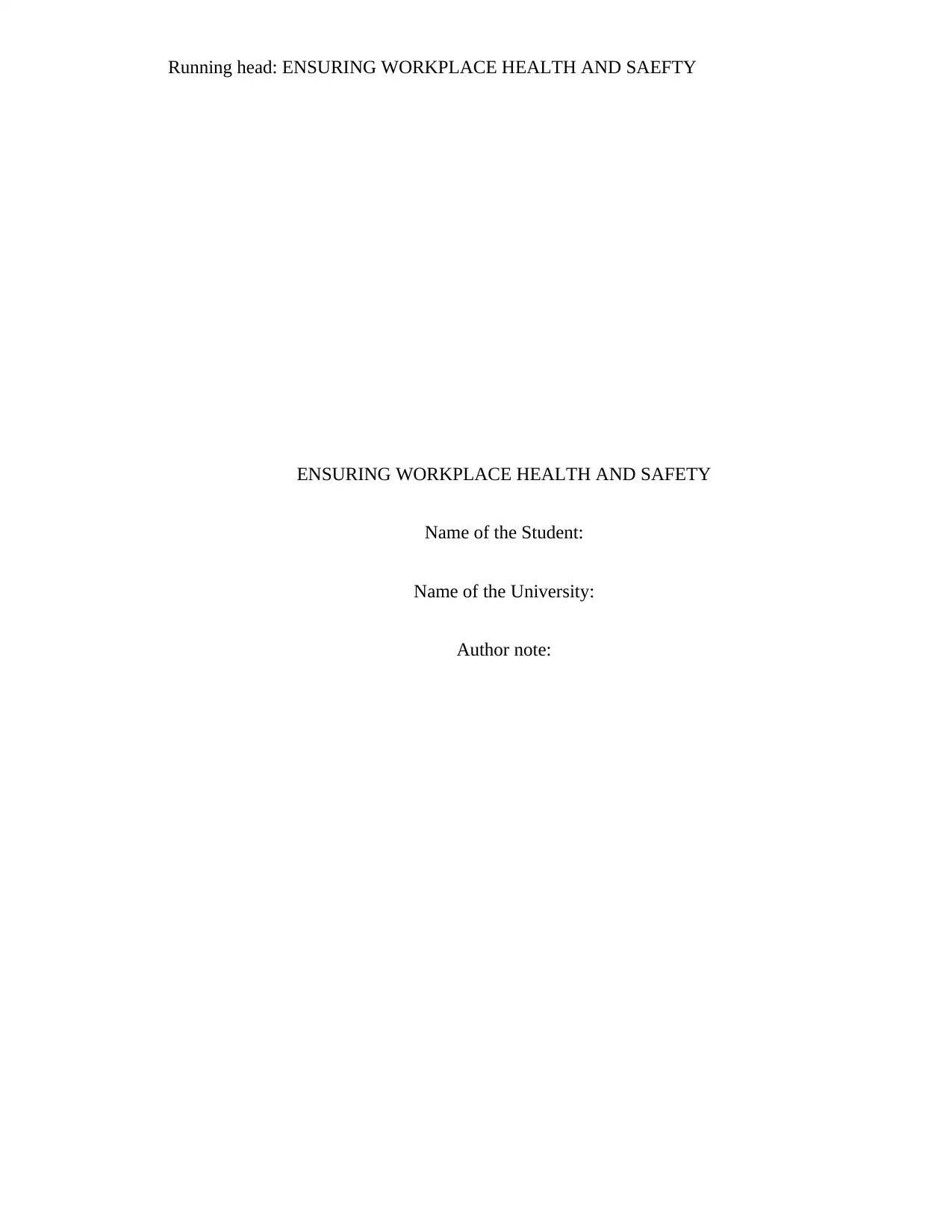
Running head: ENSURING WORKPLACE HEALTH AND SAEFTY
ENSURING WORKPLACE HEALTH AND SAFETY
Name of the Student:
Name of the University:
Author note:
ENSURING WORKPLACE HEALTH AND SAFETY
Name of the Student:
Name of the University:
Author note:
Paraphrase This Document
Need a fresh take? Get an instant paraphrase of this document with our AI Paraphraser
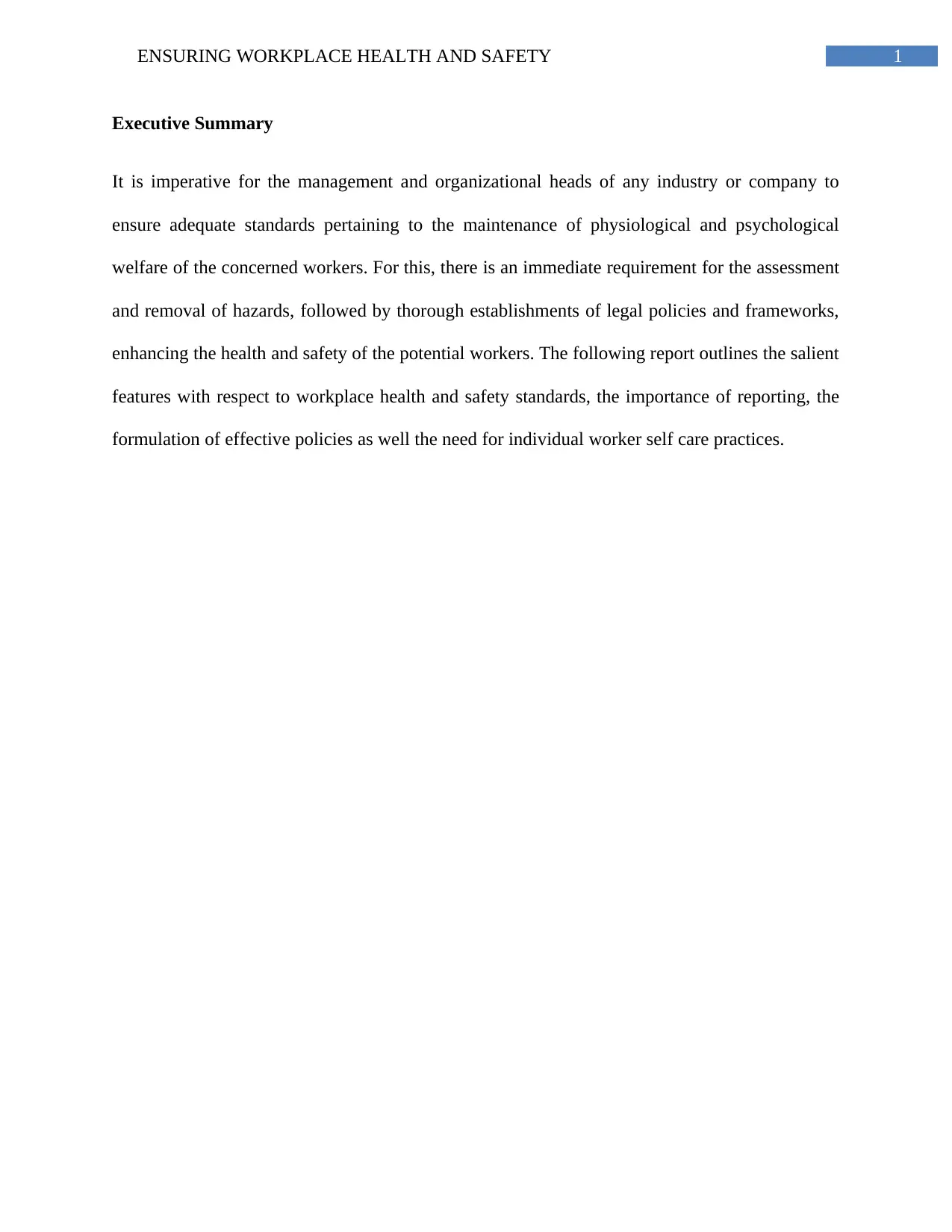
1ENSURING WORKPLACE HEALTH AND SAFETY
Executive Summary
It is imperative for the management and organizational heads of any industry or company to
ensure adequate standards pertaining to the maintenance of physiological and psychological
welfare of the concerned workers. For this, there is an immediate requirement for the assessment
and removal of hazards, followed by thorough establishments of legal policies and frameworks,
enhancing the health and safety of the potential workers. The following report outlines the salient
features with respect to workplace health and safety standards, the importance of reporting, the
formulation of effective policies as well the need for individual worker self care practices.
Executive Summary
It is imperative for the management and organizational heads of any industry or company to
ensure adequate standards pertaining to the maintenance of physiological and psychological
welfare of the concerned workers. For this, there is an immediate requirement for the assessment
and removal of hazards, followed by thorough establishments of legal policies and frameworks,
enhancing the health and safety of the potential workers. The following report outlines the salient
features with respect to workplace health and safety standards, the importance of reporting, the
formulation of effective policies as well the need for individual worker self care practices.
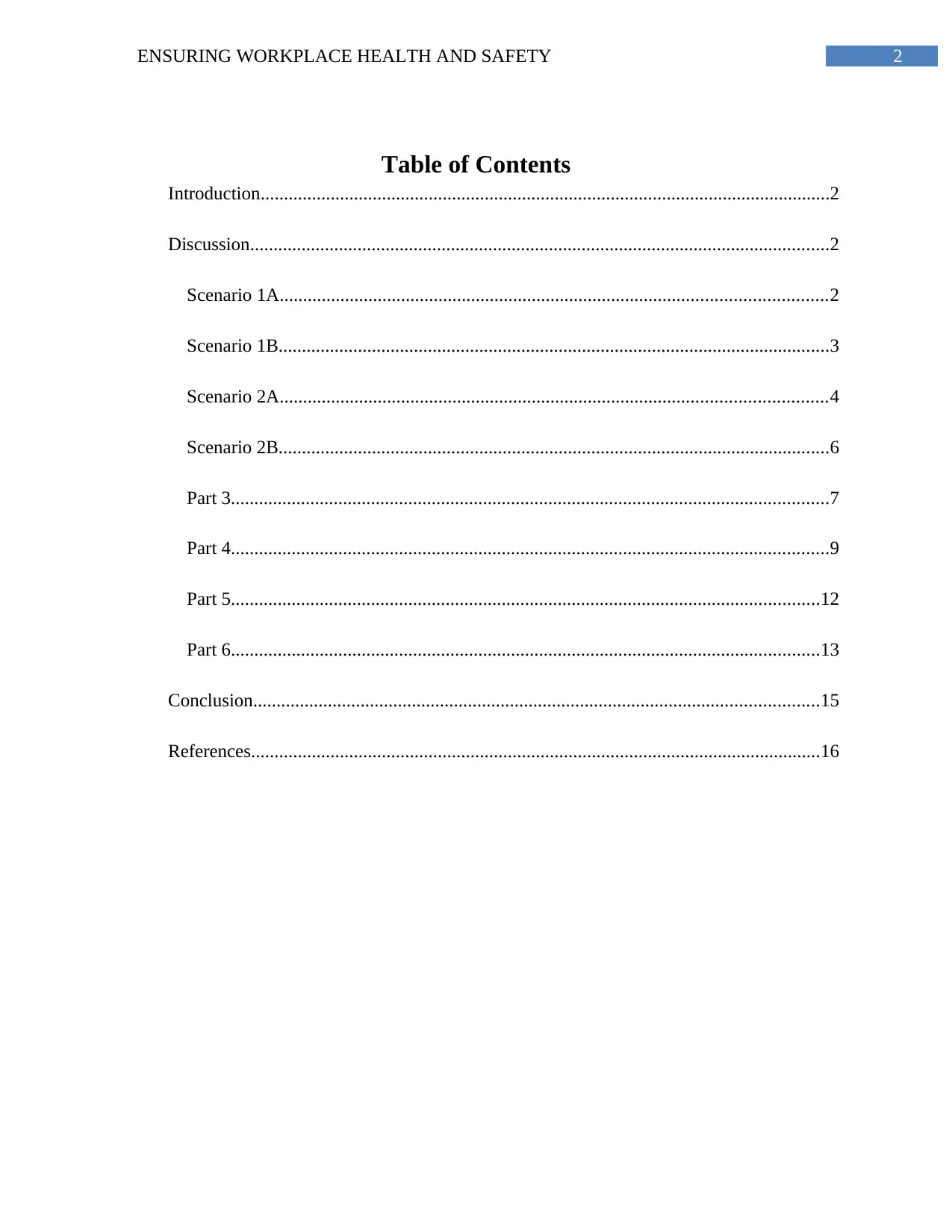
2ENSURING WORKPLACE HEALTH AND SAFETY
Table of Contents
Introduction..........................................................................................................................2
Discussion............................................................................................................................2
Scenario 1A.....................................................................................................................2
Scenario 1B......................................................................................................................3
Scenario 2A.....................................................................................................................4
Scenario 2B......................................................................................................................6
Part 3................................................................................................................................7
Part 4................................................................................................................................9
Part 5..............................................................................................................................12
Part 6..............................................................................................................................13
Conclusion.........................................................................................................................15
References..........................................................................................................................16
Table of Contents
Introduction..........................................................................................................................2
Discussion............................................................................................................................2
Scenario 1A.....................................................................................................................2
Scenario 1B......................................................................................................................3
Scenario 2A.....................................................................................................................4
Scenario 2B......................................................................................................................6
Part 3................................................................................................................................7
Part 4................................................................................................................................9
Part 5..............................................................................................................................12
Part 6..............................................................................................................................13
Conclusion.........................................................................................................................15
References..........................................................................................................................16
⊘ This is a preview!⊘
Do you want full access?
Subscribe today to unlock all pages.

Trusted by 1+ million students worldwide
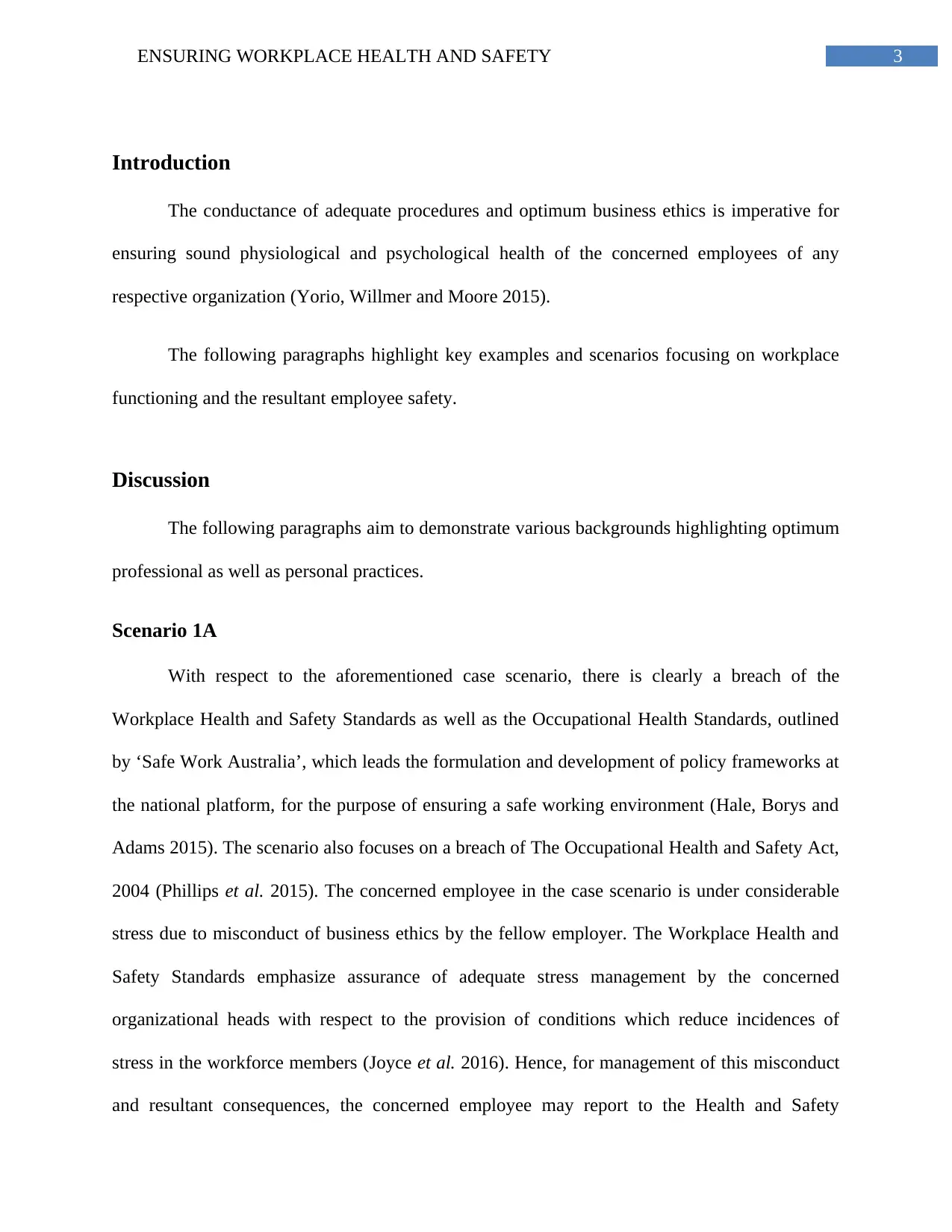
3ENSURING WORKPLACE HEALTH AND SAFETY
Introduction
The conductance of adequate procedures and optimum business ethics is imperative for
ensuring sound physiological and psychological health of the concerned employees of any
respective organization (Yorio, Willmer and Moore 2015).
The following paragraphs highlight key examples and scenarios focusing on workplace
functioning and the resultant employee safety.
Discussion
The following paragraphs aim to demonstrate various backgrounds highlighting optimum
professional as well as personal practices.
Scenario 1A
With respect to the aforementioned case scenario, there is clearly a breach of the
Workplace Health and Safety Standards as well as the Occupational Health Standards, outlined
by ‘Safe Work Australia’, which leads the formulation and development of policy frameworks at
the national platform, for the purpose of ensuring a safe working environment (Hale, Borys and
Adams 2015). The scenario also focuses on a breach of The Occupational Health and Safety Act,
2004 (Phillips et al. 2015). The concerned employee in the case scenario is under considerable
stress due to misconduct of business ethics by the fellow employer. The Workplace Health and
Safety Standards emphasize assurance of adequate stress management by the concerned
organizational heads with respect to the provision of conditions which reduce incidences of
stress in the workforce members (Joyce et al. 2016). Hence, for management of this misconduct
and resultant consequences, the concerned employee may report to the Health and Safety
Introduction
The conductance of adequate procedures and optimum business ethics is imperative for
ensuring sound physiological and psychological health of the concerned employees of any
respective organization (Yorio, Willmer and Moore 2015).
The following paragraphs highlight key examples and scenarios focusing on workplace
functioning and the resultant employee safety.
Discussion
The following paragraphs aim to demonstrate various backgrounds highlighting optimum
professional as well as personal practices.
Scenario 1A
With respect to the aforementioned case scenario, there is clearly a breach of the
Workplace Health and Safety Standards as well as the Occupational Health Standards, outlined
by ‘Safe Work Australia’, which leads the formulation and development of policy frameworks at
the national platform, for the purpose of ensuring a safe working environment (Hale, Borys and
Adams 2015). The scenario also focuses on a breach of The Occupational Health and Safety Act,
2004 (Phillips et al. 2015). The concerned employee in the case scenario is under considerable
stress due to misconduct of business ethics by the fellow employer. The Workplace Health and
Safety Standards emphasize assurance of adequate stress management by the concerned
organizational heads with respect to the provision of conditions which reduce incidences of
stress in the workforce members (Joyce et al. 2016). Hence, for management of this misconduct
and resultant consequences, the concerned employee may report to the Health and Safety
Paraphrase This Document
Need a fresh take? Get an instant paraphrase of this document with our AI Paraphraser
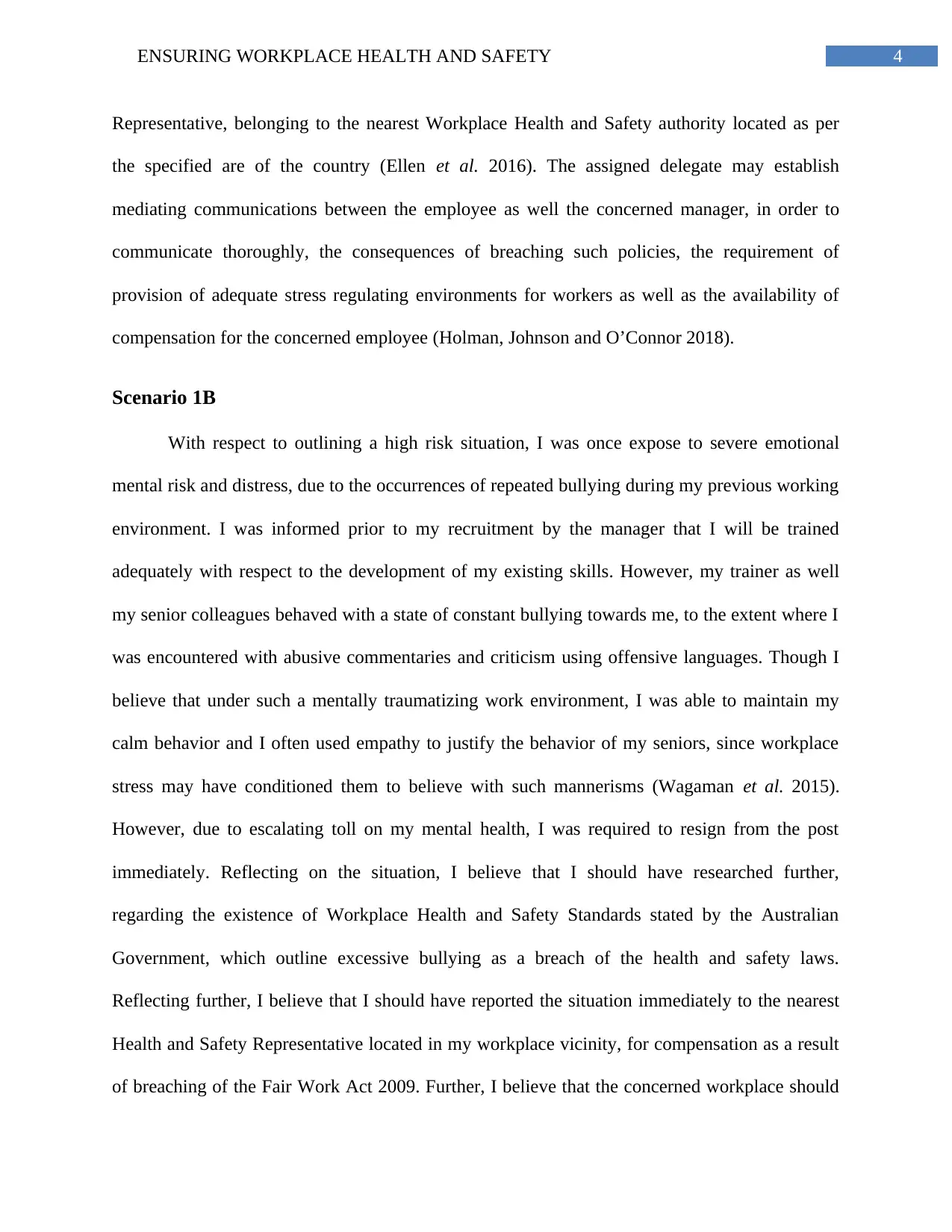
4ENSURING WORKPLACE HEALTH AND SAFETY
Representative, belonging to the nearest Workplace Health and Safety authority located as per
the specified are of the country (Ellen et al. 2016). The assigned delegate may establish
mediating communications between the employee as well the concerned manager, in order to
communicate thoroughly, the consequences of breaching such policies, the requirement of
provision of adequate stress regulating environments for workers as well as the availability of
compensation for the concerned employee (Holman, Johnson and O’Connor 2018).
Scenario 1B
With respect to outlining a high risk situation, I was once expose to severe emotional
mental risk and distress, due to the occurrences of repeated bullying during my previous working
environment. I was informed prior to my recruitment by the manager that I will be trained
adequately with respect to the development of my existing skills. However, my trainer as well
my senior colleagues behaved with a state of constant bullying towards me, to the extent where I
was encountered with abusive commentaries and criticism using offensive languages. Though I
believe that under such a mentally traumatizing work environment, I was able to maintain my
calm behavior and I often used empathy to justify the behavior of my seniors, since workplace
stress may have conditioned them to believe with such mannerisms (Wagaman et al. 2015).
However, due to escalating toll on my mental health, I was required to resign from the post
immediately. Reflecting on the situation, I believe that I should have researched further,
regarding the existence of Workplace Health and Safety Standards stated by the Australian
Government, which outline excessive bullying as a breach of the health and safety laws.
Reflecting further, I believe that I should have reported the situation immediately to the nearest
Health and Safety Representative located in my workplace vicinity, for compensation as a result
of breaching of the Fair Work Act 2009. Further, I believe that the concerned workplace should
Representative, belonging to the nearest Workplace Health and Safety authority located as per
the specified are of the country (Ellen et al. 2016). The assigned delegate may establish
mediating communications between the employee as well the concerned manager, in order to
communicate thoroughly, the consequences of breaching such policies, the requirement of
provision of adequate stress regulating environments for workers as well as the availability of
compensation for the concerned employee (Holman, Johnson and O’Connor 2018).
Scenario 1B
With respect to outlining a high risk situation, I was once expose to severe emotional
mental risk and distress, due to the occurrences of repeated bullying during my previous working
environment. I was informed prior to my recruitment by the manager that I will be trained
adequately with respect to the development of my existing skills. However, my trainer as well
my senior colleagues behaved with a state of constant bullying towards me, to the extent where I
was encountered with abusive commentaries and criticism using offensive languages. Though I
believe that under such a mentally traumatizing work environment, I was able to maintain my
calm behavior and I often used empathy to justify the behavior of my seniors, since workplace
stress may have conditioned them to believe with such mannerisms (Wagaman et al. 2015).
However, due to escalating toll on my mental health, I was required to resign from the post
immediately. Reflecting on the situation, I believe that I should have researched further,
regarding the existence of Workplace Health and Safety Standards stated by the Australian
Government, which outline excessive bullying as a breach of the health and safety laws.
Reflecting further, I believe that I should have reported the situation immediately to the nearest
Health and Safety Representative located in my workplace vicinity, for compensation as a result
of breaching of the Fair Work Act 2009. Further, I believe that the concerned workplace should
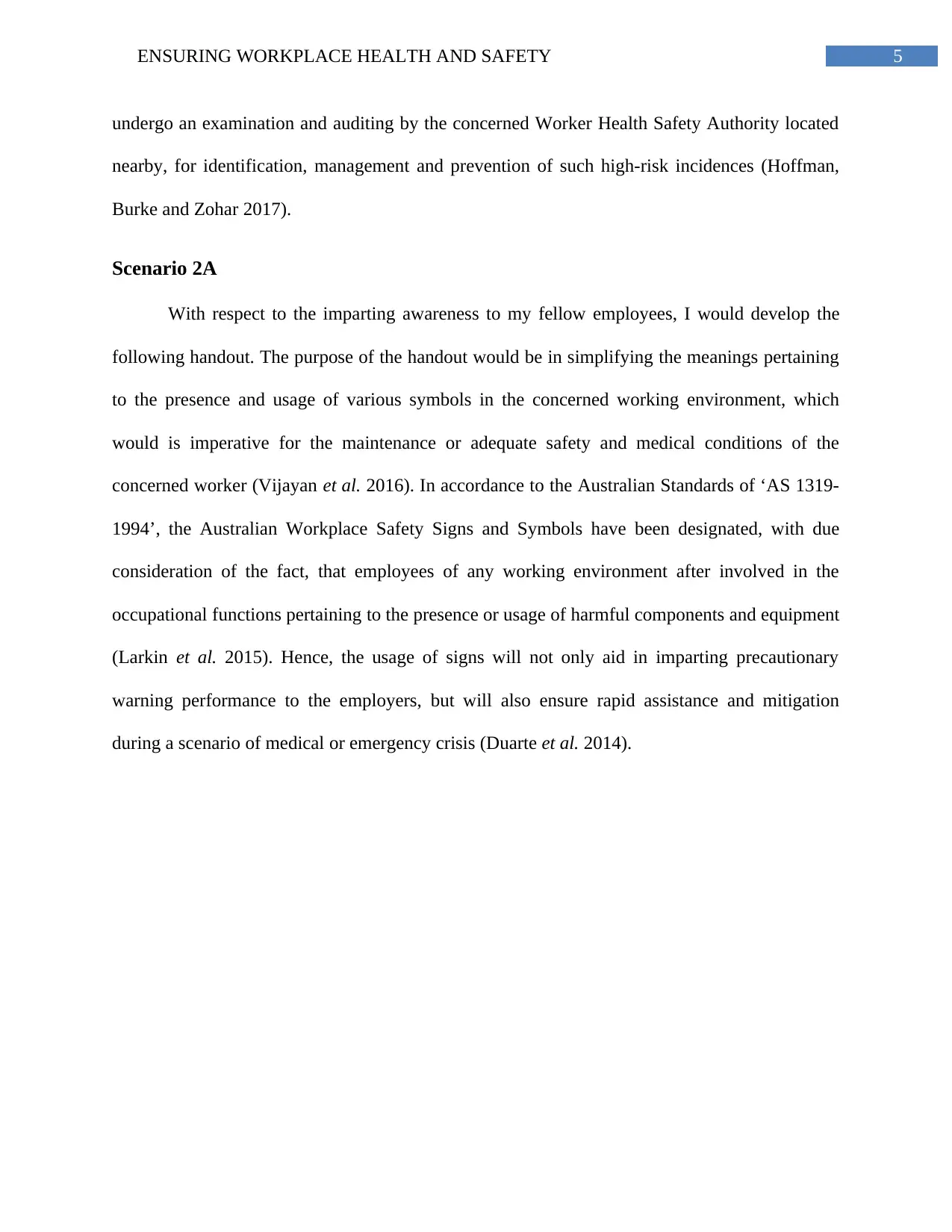
5ENSURING WORKPLACE HEALTH AND SAFETY
undergo an examination and auditing by the concerned Worker Health Safety Authority located
nearby, for identification, management and prevention of such high-risk incidences (Hoffman,
Burke and Zohar 2017).
Scenario 2A
With respect to the imparting awareness to my fellow employees, I would develop the
following handout. The purpose of the handout would be in simplifying the meanings pertaining
to the presence and usage of various symbols in the concerned working environment, which
would is imperative for the maintenance or adequate safety and medical conditions of the
concerned worker (Vijayan et al. 2016). In accordance to the Australian Standards of ‘AS 1319-
1994’, the Australian Workplace Safety Signs and Symbols have been designated, with due
consideration of the fact, that employees of any working environment after involved in the
occupational functions pertaining to the presence or usage of harmful components and equipment
(Larkin et al. 2015). Hence, the usage of signs will not only aid in imparting precautionary
warning performance to the employers, but will also ensure rapid assistance and mitigation
during a scenario of medical or emergency crisis (Duarte et al. 2014).
undergo an examination and auditing by the concerned Worker Health Safety Authority located
nearby, for identification, management and prevention of such high-risk incidences (Hoffman,
Burke and Zohar 2017).
Scenario 2A
With respect to the imparting awareness to my fellow employees, I would develop the
following handout. The purpose of the handout would be in simplifying the meanings pertaining
to the presence and usage of various symbols in the concerned working environment, which
would is imperative for the maintenance or adequate safety and medical conditions of the
concerned worker (Vijayan et al. 2016). In accordance to the Australian Standards of ‘AS 1319-
1994’, the Australian Workplace Safety Signs and Symbols have been designated, with due
consideration of the fact, that employees of any working environment after involved in the
occupational functions pertaining to the presence or usage of harmful components and equipment
(Larkin et al. 2015). Hence, the usage of signs will not only aid in imparting precautionary
warning performance to the employers, but will also ensure rapid assistance and mitigation
during a scenario of medical or emergency crisis (Duarte et al. 2014).
⊘ This is a preview!⊘
Do you want full access?
Subscribe today to unlock all pages.

Trusted by 1+ million students worldwide
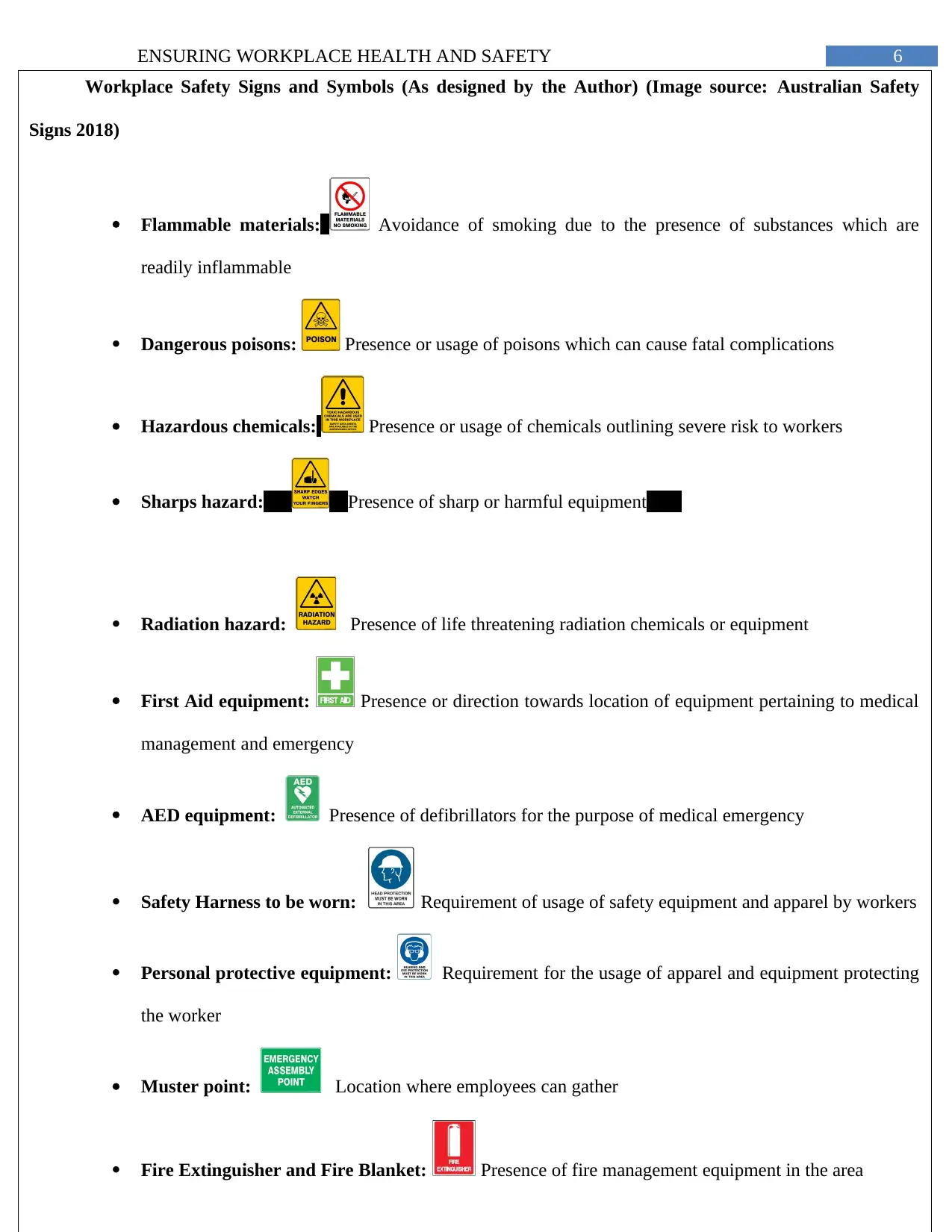
6ENSURING WORKPLACE HEALTH AND SAFETY
Workplace Safety Signs and Symbols (As designed by the Author) (Image source: Australian Safety
Signs 2018)
Flammable materials: Avoidance of smoking due to the presence of substances which are
readily inflammable
Dangerous poisons: Presence or usage of poisons which can cause fatal complications
Hazardous chemicals: Presence or usage of chemicals outlining severe risk to workers
Sharps hazard: Presence of sharp or harmful equipmentPPre
Radiation hazard: Presence of life threatening radiation chemicals or equipment
First Aid equipment: Presence or direction towards location of equipment pertaining to medical
management and emergency
AED equipment: Presence of defibrillators for the purpose of medical emergency
Safety Harness to be worn: Requirement of usage of safety equipment and apparel by workers
Personal protective equipment: Requirement for the usage of apparel and equipment protecting
the worker
Muster point: Location where employees can gather
Fire Extinguisher and Fire Blanket: Presence of fire management equipment in the area
Workplace Safety Signs and Symbols (As designed by the Author) (Image source: Australian Safety
Signs 2018)
Flammable materials: Avoidance of smoking due to the presence of substances which are
readily inflammable
Dangerous poisons: Presence or usage of poisons which can cause fatal complications
Hazardous chemicals: Presence or usage of chemicals outlining severe risk to workers
Sharps hazard: Presence of sharp or harmful equipmentPPre
Radiation hazard: Presence of life threatening radiation chemicals or equipment
First Aid equipment: Presence or direction towards location of equipment pertaining to medical
management and emergency
AED equipment: Presence of defibrillators for the purpose of medical emergency
Safety Harness to be worn: Requirement of usage of safety equipment and apparel by workers
Personal protective equipment: Requirement for the usage of apparel and equipment protecting
the worker
Muster point: Location where employees can gather
Fire Extinguisher and Fire Blanket: Presence of fire management equipment in the area
Paraphrase This Document
Need a fresh take? Get an instant paraphrase of this document with our AI Paraphraser
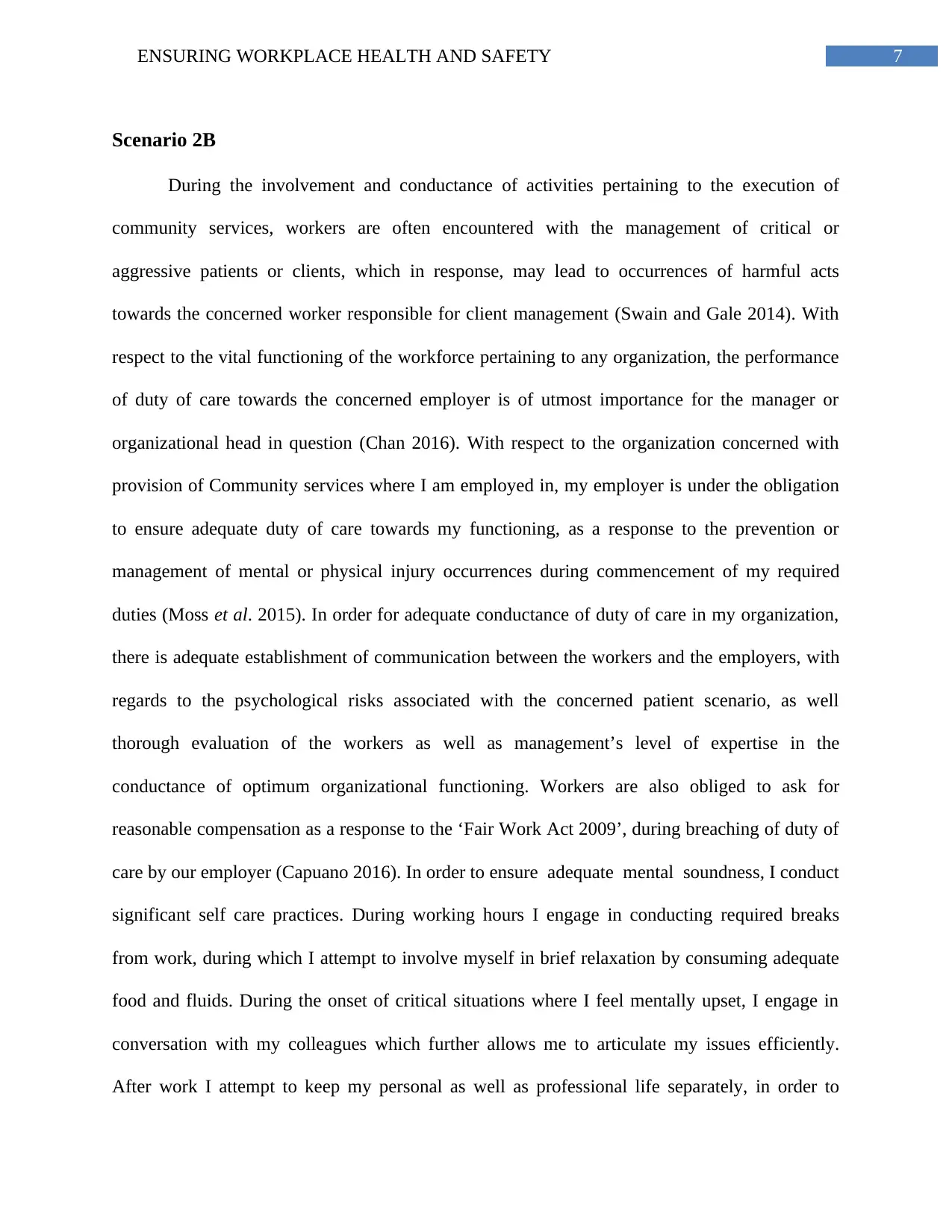
7ENSURING WORKPLACE HEALTH AND SAFETY
Scenario 2B
During the involvement and conductance of activities pertaining to the execution of
community services, workers are often encountered with the management of critical or
aggressive patients or clients, which in response, may lead to occurrences of harmful acts
towards the concerned worker responsible for client management (Swain and Gale 2014). With
respect to the vital functioning of the workforce pertaining to any organization, the performance
of duty of care towards the concerned employer is of utmost importance for the manager or
organizational head in question (Chan 2016). With respect to the organization concerned with
provision of Community services where I am employed in, my employer is under the obligation
to ensure adequate duty of care towards my functioning, as a response to the prevention or
management of mental or physical injury occurrences during commencement of my required
duties (Moss et al. 2015). In order for adequate conductance of duty of care in my organization,
there is adequate establishment of communication between the workers and the employers, with
regards to the psychological risks associated with the concerned patient scenario, as well
thorough evaluation of the workers as well as management’s level of expertise in the
conductance of optimum organizational functioning. Workers are also obliged to ask for
reasonable compensation as a response to the ‘Fair Work Act 2009’, during breaching of duty of
care by our employer (Capuano 2016). In order to ensure adequate mental soundness, I conduct
significant self care practices. During working hours I engage in conducting required breaks
from work, during which I attempt to involve myself in brief relaxation by consuming adequate
food and fluids. During the onset of critical situations where I feel mentally upset, I engage in
conversation with my colleagues which further allows me to articulate my issues efficiently.
After work I attempt to keep my personal as well as professional life separately, in order to
Scenario 2B
During the involvement and conductance of activities pertaining to the execution of
community services, workers are often encountered with the management of critical or
aggressive patients or clients, which in response, may lead to occurrences of harmful acts
towards the concerned worker responsible for client management (Swain and Gale 2014). With
respect to the vital functioning of the workforce pertaining to any organization, the performance
of duty of care towards the concerned employer is of utmost importance for the manager or
organizational head in question (Chan 2016). With respect to the organization concerned with
provision of Community services where I am employed in, my employer is under the obligation
to ensure adequate duty of care towards my functioning, as a response to the prevention or
management of mental or physical injury occurrences during commencement of my required
duties (Moss et al. 2015). In order for adequate conductance of duty of care in my organization,
there is adequate establishment of communication between the workers and the employers, with
regards to the psychological risks associated with the concerned patient scenario, as well
thorough evaluation of the workers as well as management’s level of expertise in the
conductance of optimum organizational functioning. Workers are also obliged to ask for
reasonable compensation as a response to the ‘Fair Work Act 2009’, during breaching of duty of
care by our employer (Capuano 2016). In order to ensure adequate mental soundness, I conduct
significant self care practices. During working hours I engage in conducting required breaks
from work, during which I attempt to involve myself in brief relaxation by consuming adequate
food and fluids. During the onset of critical situations where I feel mentally upset, I engage in
conversation with my colleagues which further allows me to articulate my issues efficiently.
After work I attempt to keep my personal as well as professional life separately, in order to
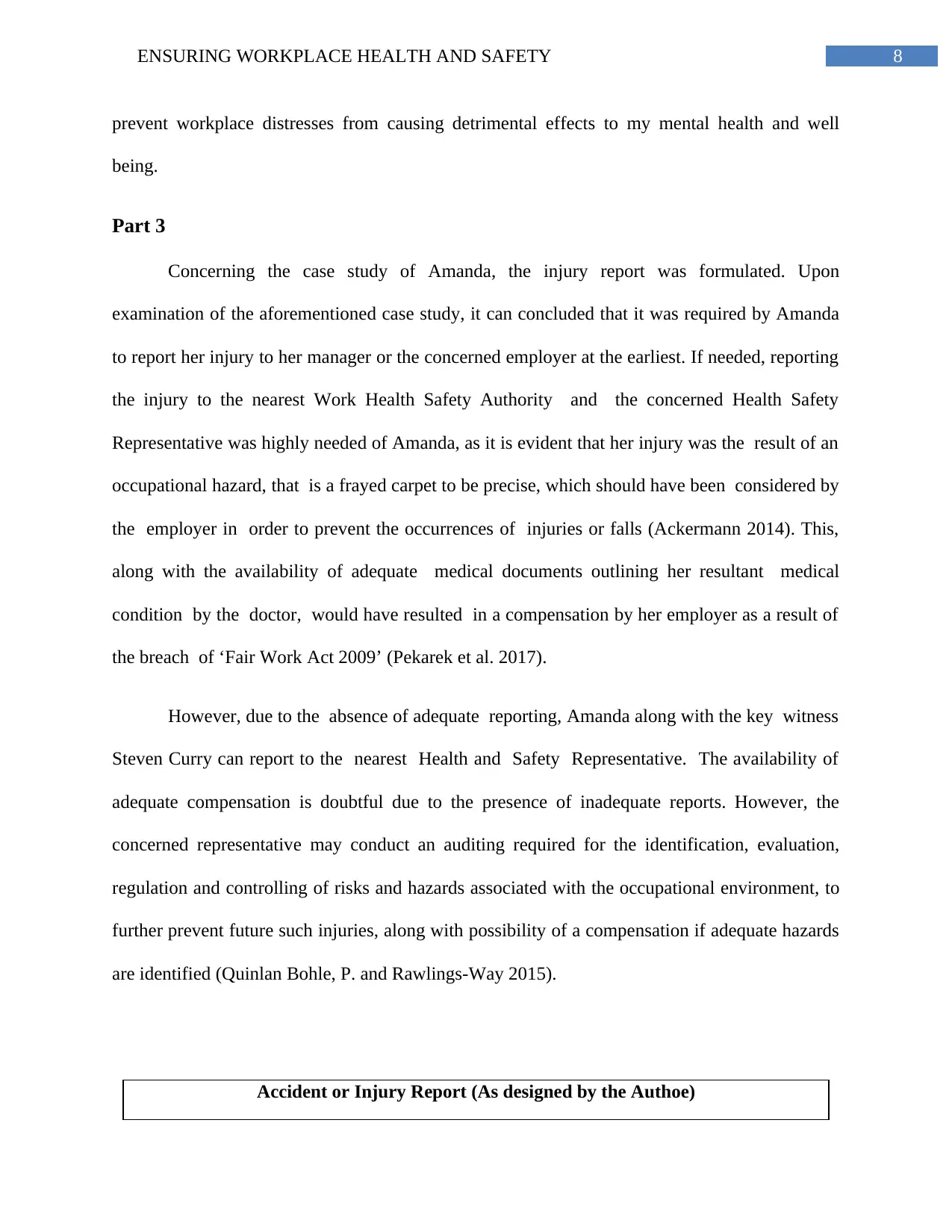
8ENSURING WORKPLACE HEALTH AND SAFETY
prevent workplace distresses from causing detrimental effects to my mental health and well
being.
Part 3
Concerning the case study of Amanda, the injury report was formulated. Upon
examination of the aforementioned case study, it can concluded that it was required by Amanda
to report her injury to her manager or the concerned employer at the earliest. If needed, reporting
the injury to the nearest Work Health Safety Authority and the concerned Health Safety
Representative was highly needed of Amanda, as it is evident that her injury was the result of an
occupational hazard, that is a frayed carpet to be precise, which should have been considered by
the employer in order to prevent the occurrences of injuries or falls (Ackermann 2014). This,
along with the availability of adequate medical documents outlining her resultant medical
condition by the doctor, would have resulted in a compensation by her employer as a result of
the breach of ‘Fair Work Act 2009’ (Pekarek et al. 2017).
However, due to the absence of adequate reporting, Amanda along with the key witness
Steven Curry can report to the nearest Health and Safety Representative. The availability of
adequate compensation is doubtful due to the presence of inadequate reports. However, the
concerned representative may conduct an auditing required for the identification, evaluation,
regulation and controlling of risks and hazards associated with the occupational environment, to
further prevent future such injuries, along with possibility of a compensation if adequate hazards
are identified (Quinlan Bohle, P. and Rawlings-Way 2015).
Accident or Injury Report (As designed by the Authoe)
prevent workplace distresses from causing detrimental effects to my mental health and well
being.
Part 3
Concerning the case study of Amanda, the injury report was formulated. Upon
examination of the aforementioned case study, it can concluded that it was required by Amanda
to report her injury to her manager or the concerned employer at the earliest. If needed, reporting
the injury to the nearest Work Health Safety Authority and the concerned Health Safety
Representative was highly needed of Amanda, as it is evident that her injury was the result of an
occupational hazard, that is a frayed carpet to be precise, which should have been considered by
the employer in order to prevent the occurrences of injuries or falls (Ackermann 2014). This,
along with the availability of adequate medical documents outlining her resultant medical
condition by the doctor, would have resulted in a compensation by her employer as a result of
the breach of ‘Fair Work Act 2009’ (Pekarek et al. 2017).
However, due to the absence of adequate reporting, Amanda along with the key witness
Steven Curry can report to the nearest Health and Safety Representative. The availability of
adequate compensation is doubtful due to the presence of inadequate reports. However, the
concerned representative may conduct an auditing required for the identification, evaluation,
regulation and controlling of risks and hazards associated with the occupational environment, to
further prevent future such injuries, along with possibility of a compensation if adequate hazards
are identified (Quinlan Bohle, P. and Rawlings-Way 2015).
Accident or Injury Report (As designed by the Authoe)
⊘ This is a preview!⊘
Do you want full access?
Subscribe today to unlock all pages.

Trusted by 1+ million students worldwide
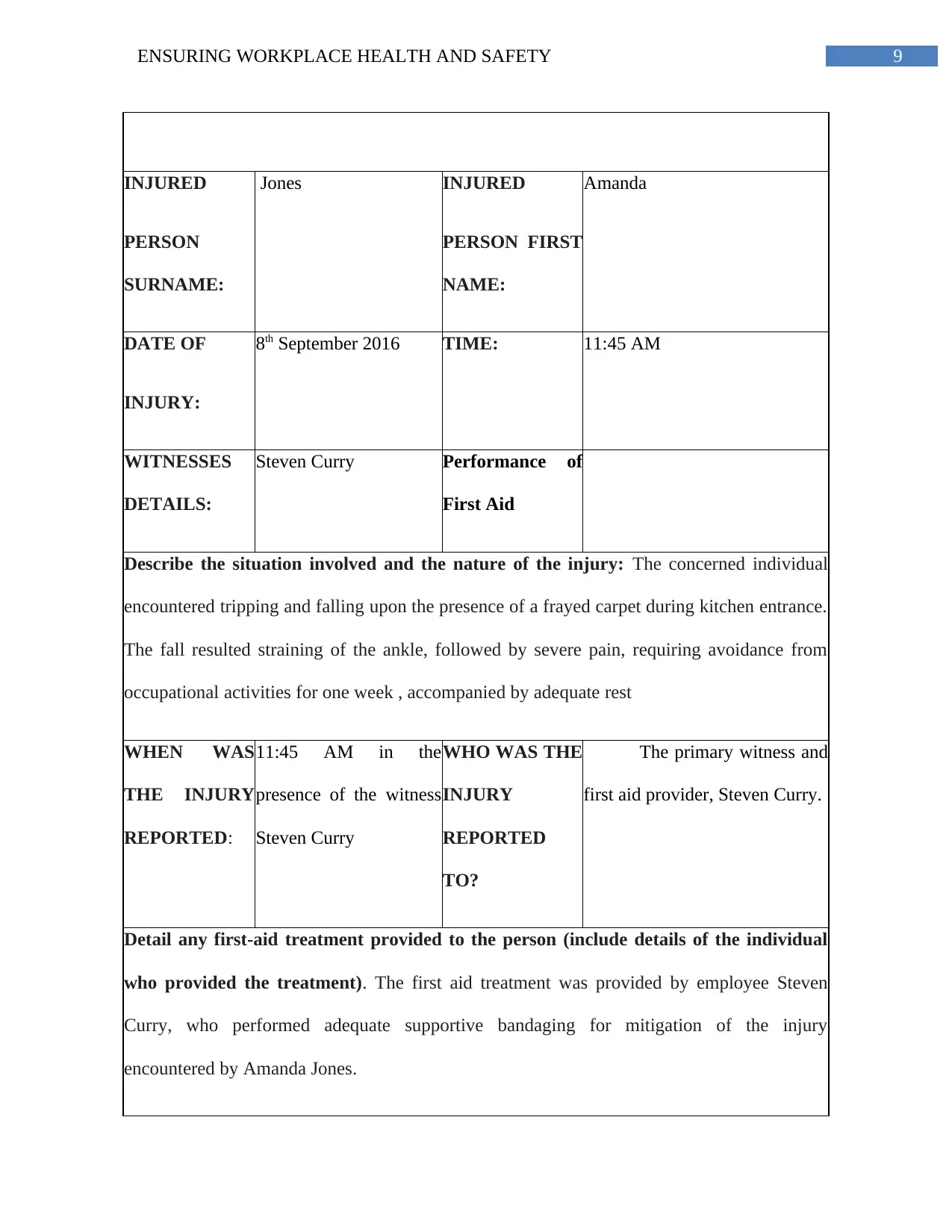
9ENSURING WORKPLACE HEALTH AND SAFETY
INJURED
PERSON
SURNAME:
Jones INJURED
PERSON FIRST
NAME:
Amanda
DATE OF
INJURY:
8th September 2016 TIME: 11:45 AM
WITNESSES
DETAILS:
Steven Curry Performance of
First Aid
Describe the situation involved and the nature of the injury: The concerned individual
encountered tripping and falling upon the presence of a frayed carpet during kitchen entrance.
The fall resulted straining of the ankle, followed by severe pain, requiring avoidance from
occupational activities for one week , accompanied by adequate rest
WHEN WAS
THE INJURY
REPORTED:
11:45 AM in the
presence of the witness
Steven Curry
WHO WAS THE
INJURY
REPORTED
TO?
The primary witness and
first aid provider, Steven Curry.
Detail any first-aid treatment provided to the person (include details of the individual
who provided the treatment). The first aid treatment was provided by employee Steven
Curry, who performed adequate supportive bandaging for mitigation of the injury
encountered by Amanda Jones.
INJURED
PERSON
SURNAME:
Jones INJURED
PERSON FIRST
NAME:
Amanda
DATE OF
INJURY:
8th September 2016 TIME: 11:45 AM
WITNESSES
DETAILS:
Steven Curry Performance of
First Aid
Describe the situation involved and the nature of the injury: The concerned individual
encountered tripping and falling upon the presence of a frayed carpet during kitchen entrance.
The fall resulted straining of the ankle, followed by severe pain, requiring avoidance from
occupational activities for one week , accompanied by adequate rest
WHEN WAS
THE INJURY
REPORTED:
11:45 AM in the
presence of the witness
Steven Curry
WHO WAS THE
INJURY
REPORTED
TO?
The primary witness and
first aid provider, Steven Curry.
Detail any first-aid treatment provided to the person (include details of the individual
who provided the treatment). The first aid treatment was provided by employee Steven
Curry, who performed adequate supportive bandaging for mitigation of the injury
encountered by Amanda Jones.
Paraphrase This Document
Need a fresh take? Get an instant paraphrase of this document with our AI Paraphraser
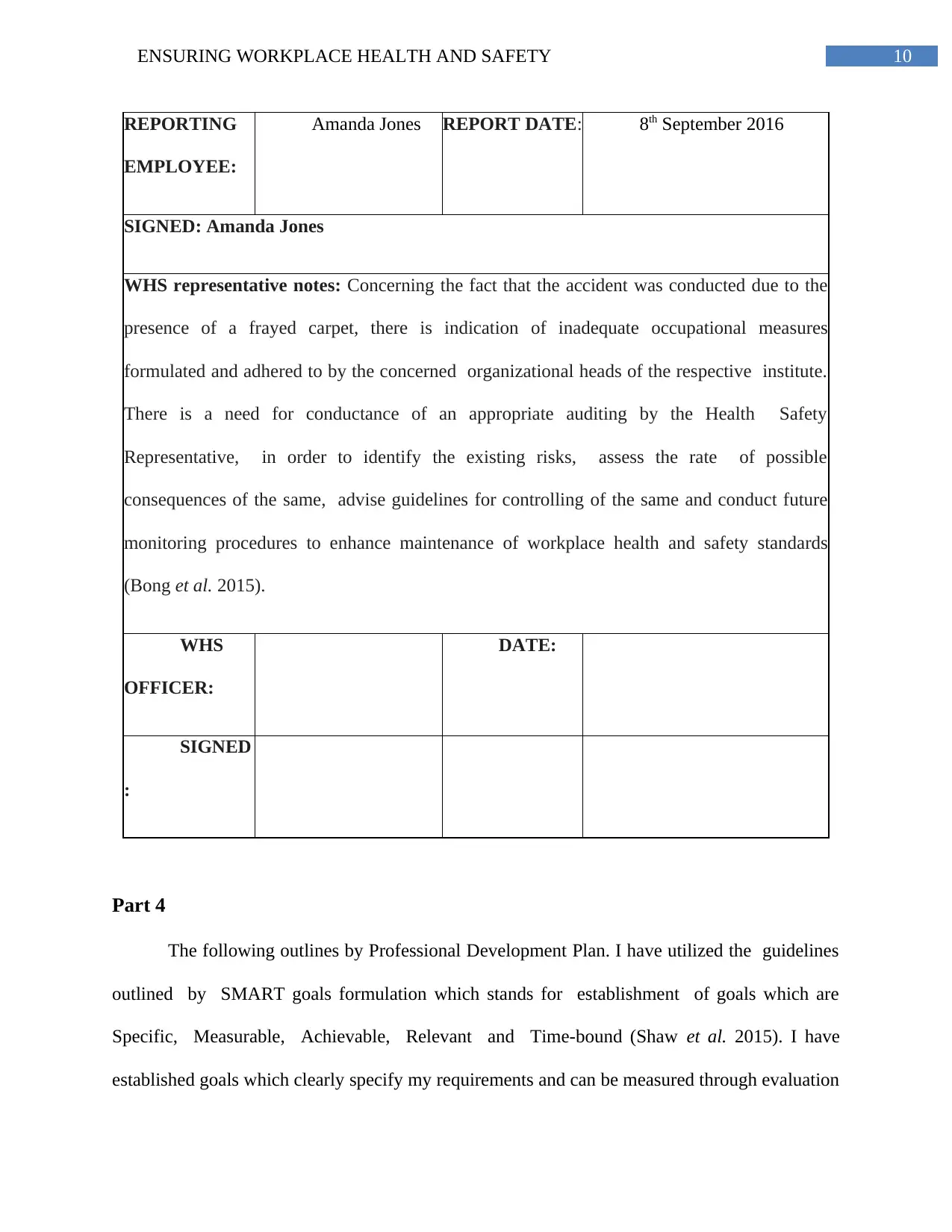
10ENSURING WORKPLACE HEALTH AND SAFETY
REPORTING
EMPLOYEE:
Amanda Jones REPORT DATE: 8th September 2016
SIGNED: Amanda Jones
WHS representative notes: Concerning the fact that the accident was conducted due to the
presence of a frayed carpet, there is indication of inadequate occupational measures
formulated and adhered to by the concerned organizational heads of the respective institute.
There is a need for conductance of an appropriate auditing by the Health Safety
Representative, in order to identify the existing risks, assess the rate of possible
consequences of the same, advise guidelines for controlling of the same and conduct future
monitoring procedures to enhance maintenance of workplace health and safety standards
(Bong et al. 2015).
WHS
OFFICER:
DATE:
SIGNED
:
Part 4
The following outlines by Professional Development Plan. I have utilized the guidelines
outlined by SMART goals formulation which stands for establishment of goals which are
Specific, Measurable, Achievable, Relevant and Time-bound (Shaw et al. 2015). I have
established goals which clearly specify my requirements and can be measured through evaluation
REPORTING
EMPLOYEE:
Amanda Jones REPORT DATE: 8th September 2016
SIGNED: Amanda Jones
WHS representative notes: Concerning the fact that the accident was conducted due to the
presence of a frayed carpet, there is indication of inadequate occupational measures
formulated and adhered to by the concerned organizational heads of the respective institute.
There is a need for conductance of an appropriate auditing by the Health Safety
Representative, in order to identify the existing risks, assess the rate of possible
consequences of the same, advise guidelines for controlling of the same and conduct future
monitoring procedures to enhance maintenance of workplace health and safety standards
(Bong et al. 2015).
WHS
OFFICER:
DATE:
SIGNED
:
Part 4
The following outlines by Professional Development Plan. I have utilized the guidelines
outlined by SMART goals formulation which stands for establishment of goals which are
Specific, Measurable, Achievable, Relevant and Time-bound (Shaw et al. 2015). I have
established goals which clearly specify my requirements and can be measured through evaluation
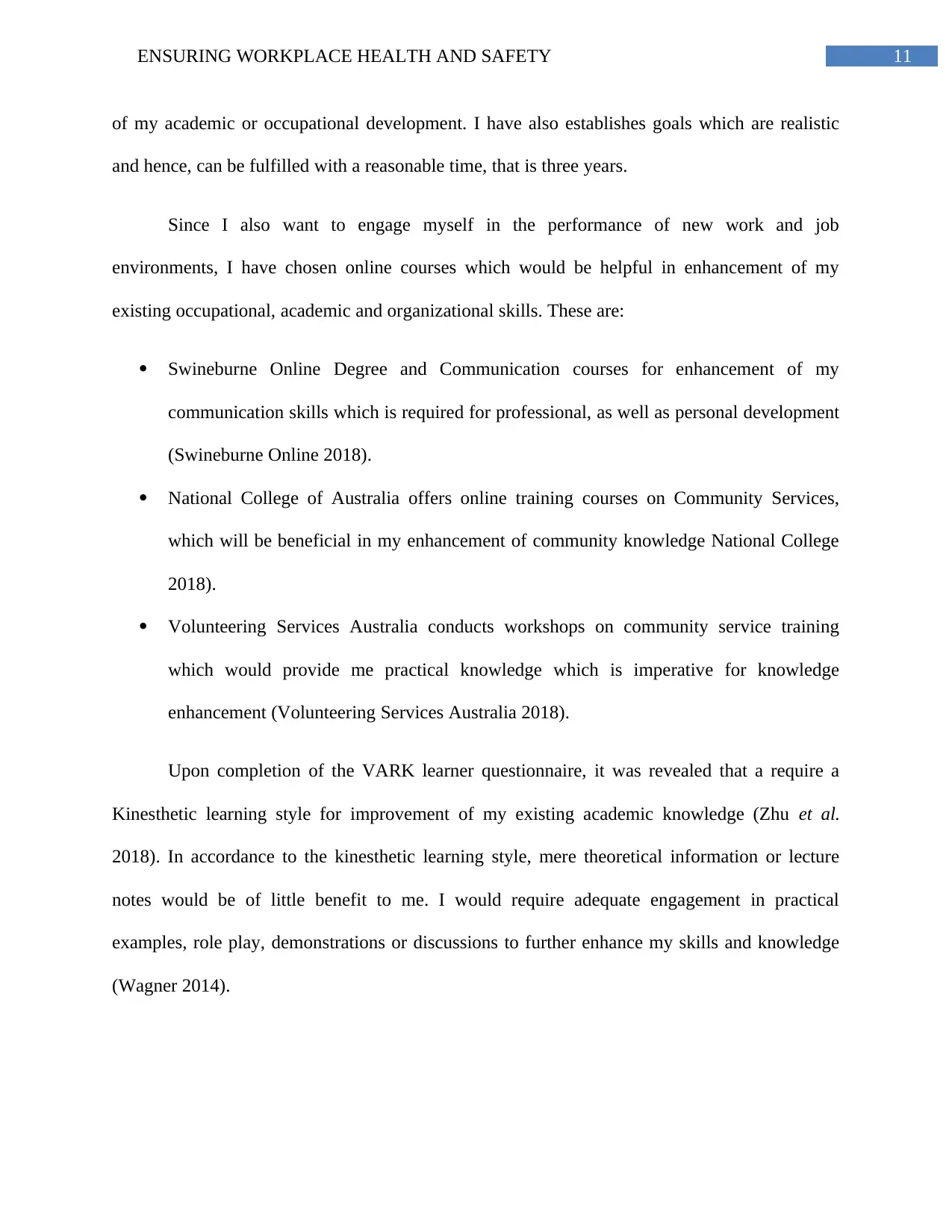
11ENSURING WORKPLACE HEALTH AND SAFETY
of my academic or occupational development. I have also establishes goals which are realistic
and hence, can be fulfilled with a reasonable time, that is three years.
Since I also want to engage myself in the performance of new work and job
environments, I have chosen online courses which would be helpful in enhancement of my
existing occupational, academic and organizational skills. These are:
Swineburne Online Degree and Communication courses for enhancement of my
communication skills which is required for professional, as well as personal development
(Swineburne Online 2018).
National College of Australia offers online training courses on Community Services,
which will be beneficial in my enhancement of community knowledge National College
2018).
Volunteering Services Australia conducts workshops on community service training
which would provide me practical knowledge which is imperative for knowledge
enhancement (Volunteering Services Australia 2018).
Upon completion of the VARK learner questionnaire, it was revealed that a require a
Kinesthetic learning style for improvement of my existing academic knowledge (Zhu et al.
2018). In accordance to the kinesthetic learning style, mere theoretical information or lecture
notes would be of little benefit to me. I would require adequate engagement in practical
examples, role play, demonstrations or discussions to further enhance my skills and knowledge
(Wagner 2014).
of my academic or occupational development. I have also establishes goals which are realistic
and hence, can be fulfilled with a reasonable time, that is three years.
Since I also want to engage myself in the performance of new work and job
environments, I have chosen online courses which would be helpful in enhancement of my
existing occupational, academic and organizational skills. These are:
Swineburne Online Degree and Communication courses for enhancement of my
communication skills which is required for professional, as well as personal development
(Swineburne Online 2018).
National College of Australia offers online training courses on Community Services,
which will be beneficial in my enhancement of community knowledge National College
2018).
Volunteering Services Australia conducts workshops on community service training
which would provide me practical knowledge which is imperative for knowledge
enhancement (Volunteering Services Australia 2018).
Upon completion of the VARK learner questionnaire, it was revealed that a require a
Kinesthetic learning style for improvement of my existing academic knowledge (Zhu et al.
2018). In accordance to the kinesthetic learning style, mere theoretical information or lecture
notes would be of little benefit to me. I would require adequate engagement in practical
examples, role play, demonstrations or discussions to further enhance my skills and knowledge
(Wagner 2014).
⊘ This is a preview!⊘
Do you want full access?
Subscribe today to unlock all pages.

Trusted by 1+ million students worldwide
1 out of 22
Related Documents
Your All-in-One AI-Powered Toolkit for Academic Success.
+13062052269
info@desklib.com
Available 24*7 on WhatsApp / Email
![[object Object]](/_next/static/media/star-bottom.7253800d.svg)
Unlock your academic potential
Copyright © 2020–2025 A2Z Services. All Rights Reserved. Developed and managed by ZUCOL.





